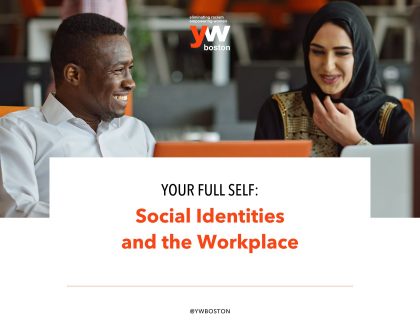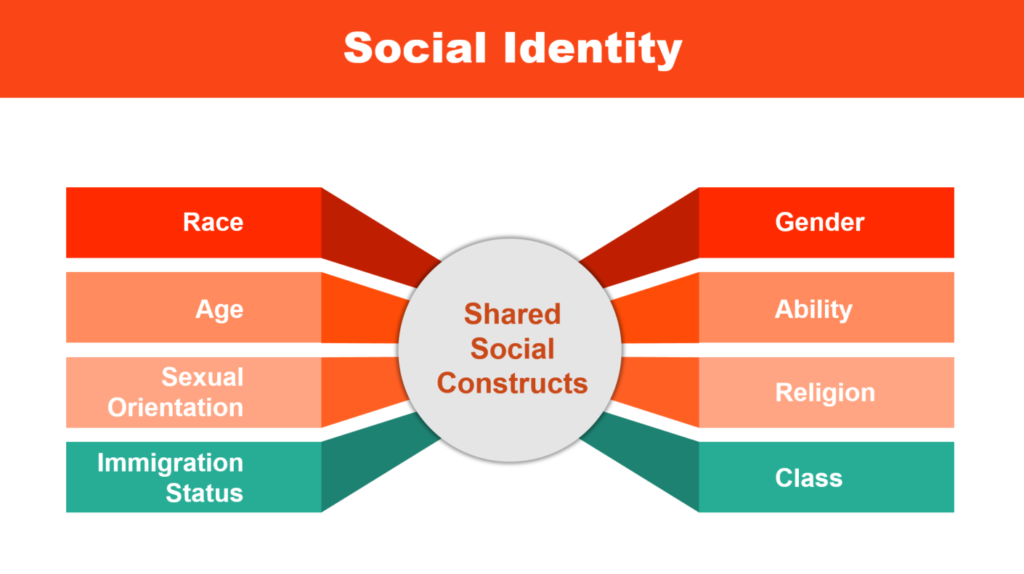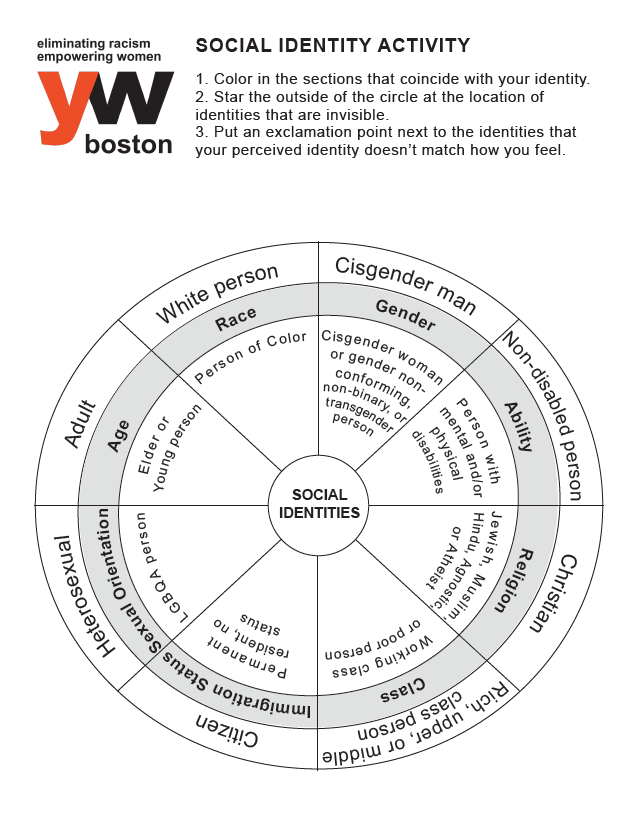Your full self: Social identities and the workplace

What do personal identities have to do with an organization’s work? Well, everything. Successful organizations take into account the various social identities of their employees in order to facilitate a thriving work environment and meet the needs of everyone involved. In order to fully commit to Diversity, Equity, and Inclusion, organizations need to not solely work to hire people of many different social identities. They also need to understand how these social identities impact the experiences of their employees, and work to ensure all employees feel welcomed, respected, supported, and valued. This works to create an inclusive workplace environment where all people feel comfortable bringing their whole selves, or identities, to work.
The “Big 8” of social identities
At YW Boston, we define identity as “The way an individual thinks about themselves, the way they are viewed by the world and the characteristics that define them.” More specifically, social identities are a specific type of identity that are the “result of shared constructions and social relations” based on human-created societal norms (Johnson, 2006).
There are an almost endless number of ways that society has categorized people over time. It is helpful to look at the social identities that are most distinct and impactful in American life today. During our “Understanding Social Identities” workshop, YW Boston dives deep into the “Big 8” social identities. When you read through the following list, consider how you personally identify:
- Race: Social construct that refers to groups of people who have differences and similarities in physical traits (skin color, bone structure, hair texture, etc.) deemed by society to be socially significant (YW Boston)
- Gender: A social and legal status and set of expectations from society, about behaviors, characteristics, and thoughts based on an individual’s perceived sexual organs (YW Boston)
- Age: How people are categorized by society’s perceptions of different age groups. (Appalachian State University)
- Ability: The diverse array of differences in physical, mental, cognitive, developmental, learning, and/or emotional make-up. It also includes mental health and the impact of social experiences such as trauma and surviving abuse. (Appalachian State University)
- Sexual Orientation: An individual’s physical and sexual attraction, or any lack thereof, as it relates to other people (YW Boston)
- Religion: A person’s or a group’s beliefs about the existence of God or gods and/or an identification with a particular religion or set of spiritual practices. (Appalachian State University)
- Immigration Status: The way in which a person is present in the United States. (National Latino Network)
- Class: The social standing of an individual or group determined by a combination of education, income and occupation (YW Boston)
One’s identity is like a unique puzzle, and how an individual categorizes themselves based on social identities makes up the puzzle pieces. The term intersectionality refers to the way in which these social identities overlap and effect one another, creating overlapping and interdependent systems of discrimination or disadvantage.

Social identity is not clear-cut
While looking through the list of social identities above, you may have struggled to answer exactly how you identify. It is normal to have more knowledge and experience with certain social identities over others. It is important for individuals to take time to examine their own social identities, how they perceive themselves, how others perceive them, how these identities shape their world view and experience, and how their identities interact with each other. This practice is important for everyone because our understanding of social identities can change over time.
Each individual will feel a different connection to different aspects of their identity. This may relate to the identities you think about most often, or the ones you believe have the most impact on your daily life. For instance, if you are a U.S. citizen and most of your friends and family are U.S. citizens, too, you may not think about your citizenship status very often or how this could impact your day-to-day life. If you do not think about it often, you are also more likely to not consider or learn about the experiences of people of other immigration statuses.
Another reason social identities can be difficult to define is that how one sees themselves does not always correlate with how they are perceived by others. It is common for people to make assumptions about the people around them based on preconceived notions and on what visible or perceived, and therefore jump to conclusions about their identity. People’s interactions with colleagues, institutions, and systems are all informed by how people perceive them.
Social identity informs each individual’s relation to power and privilege
Identity plays a large part in how we move through the world, and therefore how people and systems treat us and the opportunities that are available to us.
Each of the social identities listed above interact with systems of advantage and oppression present in the United States. There are policies and practices engrained in our daily lives that benefit people of certain social identities over others, thereby maintaining the power held by those who are considered to have ‘privileged’ identities.
At YW Boston, we define privilege as “The social, political, economic, and psychological benefits of membership in a group that has institutional and structural power” and power as one’s “influence, having an effect on the behavior of self and others, and/or authority, official permission to make and enforce behavior.” While your privilege is immutable based on your personal and perceived social identities, one’s power depends on their personal standing within and among institutions. Privilege and power often correlate. However, an institution can work to empower people of all social identities, thereby breaking this link.
Explicitly, the systems that privilege specific groups over others are present in the “Big 8” identities in the following ways:
- Racism: A system of advantage based on race and supported by institutional structures, policies, and practices that create and sustain benefits for the dominant group, and structure discrimination, oppression, and disadvantage for people from disadvantaged racial groups.
- Sexism: A system of advantages that serves to privilege men, subordinate women, denigrate women-identified values and practices, enforce male dominance and control, and reinforce forms of masculinity that are dehumanizing and damaging to men; as well as Cissexism: A system of advantages that benefits cisgender people and disadvantages transgender people.
- Age: A system of advantage that benefits adults over youth and elders
- Ableism: The practices and dominant attitudes in society that devalue and limit the potential of persons with disabilities (stopableism.org)
- Homophobia: Prejudice or discrimination towards LGBTQIA+ people, ideas, and is enforced by economic structures, violence, homophobia, and transphobia
- Religious Discrimination: Treating a person or group differently because of the particular beliefs which they hold about a religion.
- Nativism: The policy of protecting the interests of native-born or established inhabitants against those of immigrants. (Oxford Dictionary)
- Classism: The systematic oppression of subordinated class groups to advantage and strengthen the dominant class groups. (classism.org)
Every person’s power and privilege are impacted by the systems listed above, whether through advantage or disadvantage, and this affects how one interacts within the workplace.
Take a moment to place your personal identities you listed before, and place them on the wheel below. Those closest to the edge of the circle are considered privileged identities, and those closest to the center are considered disadvantaged identities. Remember, these categories are not clear cut, and systems of advantage and disadvantage are not binaries. This activity can simply help you visualize how your various identities are impacted by systems.
Discussing social identity in the workplace
Social identity is at the root of how we as individuals experience the world. We do not shed our social identities when we enter the workplace. Instead, they inform how we work together and often determine who has access to power within the organization. For that reason, it is crucial to take time to ensure all employees have an understanding about social identities and their relation to power and privilege. After creating a shared understanding, organizations can provide space for employees to speak about how their personal social identities impact how their work, including their relationships with their colleagues and organizational policies.
Social identity is at the root of how we as individuals experience the world. We do not shed our social identities when we enter the workplace. Instead, they inform how we work together and often determine who has access to power. Click To TweetBy providing space to speak about identity, organizations can work to determine whether their policies and practices are equitable — such as whether social identity affects employees’ pay or access to promotions. It also affects whether an employee feels they can “bring their whole selves to work,” or feel that their expression of each of their social identities will be welcomed, respected, supported, and valued.
No organization can afford to look away from its employees’ various social identities, and how those identities affect individual and collective experiences within the organization. As McKinsey & Company states, organizations’ dedication to diversity, equity, and inclusion directly correlates to improved economic performance.
Our InclusionBoston model recognizes the importance of foregrounding these discussions about social identity, and specifically racial identity, when working to create a more inclusive workplace. The first two sessions of the five-week dialogues portion of InclusionBoston, lead participants through “Who Am I?” and “Who Are We?” in order to build trust and understanding. With this foundation, participants are able to deepen their awareness of how their organization’s practices and policies interact with systems of advantage and disadvantage, and to begin action planning to create a more equitable workspace for people of all identities.
___
InclusionBoston advances diversity, equity, and inclusion by partnering with organizations looking for improved results. Using our advanced assessment tool and the latest research on behavioral and organizational change, we partner with organizations to create an action plan and provide them with the resources needed to drive lasting change. Our customized, evidence-based approach builds internal capacity and promotes cultural change while supporting organizations throughout their journey. YW Boston also offers one-day workshops where participants explore frameworks, develop knowledge, and engage in dialogue.
Ready to unlock the power of diversity in the workplace? Click here to learn more about InclusionBoston and request your free consultation.

